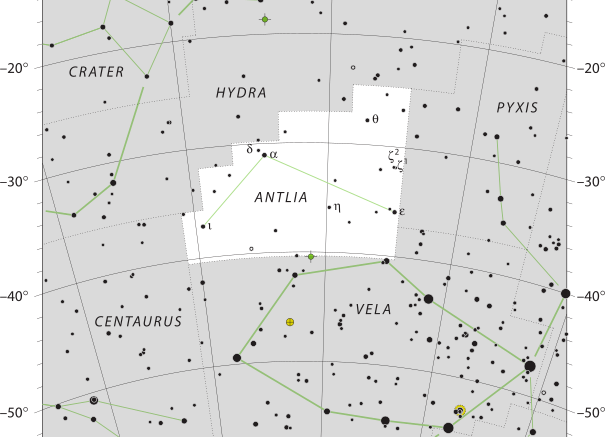The constellation Antlia is located in the Southern Celestial Hemisphere, and is represented by an air pump. The reason for using an air pump representation is a result of the name Antlia meaning “pump” in Latin. In the 18th century, Nicolas-Louis de Lacaille established the constellation with a name of Antlia Pneumatica. This name would be shortened to an abbreviated name of Antlia by John Herschel, which is the name used today. Located close to the stars forming the old constellation of the ship Argo Navis, Antlia is completely visible from latitudes south of 49 degrees north. Antlia covers 238.9 square degrees, which makes the constellation cover 0.579% of the sky and ranks as the 62nd largest modern constellations by area. Its position in the Southern Celestial Hemisphere means that the whole constellation is visible to observers south of 49°N.
Antlia is a faint constellation; with its brightest star being an orange giant named Alpha Antliae. Two star systems with known exoplanets, HD 93083 and WASP-66, lie within Antlia, as do NGC 2997, a spiral galaxy, and the Antlia Dwarf Galaxy.Two star systems with known exoplanets, HD 93083 and WASP-66, lie within Antlia, as do NGC 2997, a spiral galaxy, and the Antlia Dwarf Galaxy.
| Applicable Information | |
| Visibility In Pacific Northwest | Not Visible in the Pacific Northwest |
| Best Times To View | Not Visible in the Pacific Northwest |
| Right Ascension | 09h 27m 05.1837s– 11h 05m 55.0471s |
| Declination | 24.5425186°–−40.4246216° |
| Area | 238.9 square degrees |
| Main Stars | 3 |
| Brightest Object | α Ant |
| Meteor showers | 0 |
| Messier objects | 0 |
| Neighboring Constellations | Hydra, Pyxis, Vela, Centaurus |
History
Although Antlie was visible to the Ancient Greeks, the stars were too faint to have been included in any ancient constellations. Antlia and the stars in the modern constellation lay within an area of the sky covered by the ancient constellation Argo Navis, the Ship of the Argonauts. Due to its size, Argo Navis was split into several smaller constellations in 1763; however, some have reported that due to their faintness, the stars of Antlia did not make up part of the classical depiction of Argo Navis.
In 1751, French astronomer Nicolas-Louis de Lacaille first described the constellation in French as la Machine Pneumatique, the Pneumatic Machine. He gave the new constellation this name to commemorate the air pump invented by the French physicist Denis Papin. Lacaille depicted Antlia as a single-cylinder vacuum pump used in Papin’s initial experiments, while German astronomer Johann Bode chose the more advanced double-cylinder version. Lacaille would Latinise the name to Antlia Pneumatica on his 1763 chart, which English astronomer John Herschel would propose shrinking the name to one word in 1844. The reasoning behind this was that Lacaille himself had abbreviated his constellations thus on occasion, which became universally adopted. The International Astronomical Union adopted it as one of the 88 modern constellations in 1922.
Stars
Lacaille gave nine stars Bayer designations, labelling them Alpha to Theta, and then combining two stars next to each other as Zeta. Gould later added a tenth, Iota Antliae. Beta and Gamma Antliae would end up in the neighboring constellation Hydra once the constellation boundaries were delineated in 1930. Within the constellation’s borders, there are 42 stars brighter than or equal to apparent magnitude 6.5.
Antlia contains many faint galaxies, which observers have noted has a magnitude of 10.6 at its brightest. The brightest of the faint galaxies is NGC 2997, which is a loosely wound face-on spiral galaxy of type Sc that is nondescript in most amateur telescopes. Although when photographed, it presents bright clusters of young stars and many dark dust lanes in photographs.
The Antlia Cluster, also known as Abell S0636, is a cluster of galaxies located in the Hydra-Centaurus Supercluster. It is the third nearest cluster to the Local Group after the Virgo Cluster and the Fornax Cluster. Located in the southeastern corner of the Antlia constellation, the Antlia Cluster boasts the giant elliptical galaxies NGC 3268 and NGC 3258 as the main members, and contains about 234 galaxies in total.
Make sure to check out other articles on the site, including a brief introduction to constellations, other constellation articles, and more!

Be the first to comment on "Antlia"